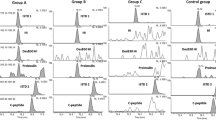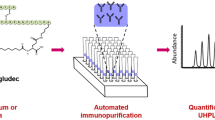Abstract
Possible fatal complications of human insulin and its synthetic analogues like hypoglycemia require precise classification and quantitative determination of these drugs both for clinical purposes as well as for forensic toxicologists. A procedure was developed for the identification and quantification of human insulin and different long-acting as well as short-acting synthetic insulins in human blood serum specimens. After an immunoaffinity purification step and separation by liquid chromatography, the insulins were characterized by their five- or sixfold protonated molecule ions and diagnostic product ions. Clinical samples of 207 diabetic and 50 non-diabetic patients after the administration of human insulin or oral antidiabetics and forensic samples were analyzed for human/synthetic insulin concentrations. The method was validated according to international guidelines. Limits of detection of the insulins ranged between 1.3 and 2.8 μU/ml. Recoveries ranged between 33.2 % and 51.7 %. Precision data was in accordance with international guidelines. Clinical samples showed concentrations of human insulin lower than 301 μU/ml. Our liquid chromatography tandem mass spectrometry procedure allows unambiguous identification and quantification of the intact human insulin and its intact synthetic analogues Humalog®, Novolog®, Apidra®, Lantus®, and Levemir® in human blood serum in clinical and overdose cases. The assay could be successfully tested in patients with diabetes mellitus on therapy with insulins or oral antidiabetics.


Similar content being viewed by others
References
Karam JH. Pancreatic hormones and diabetes mellitus In: Basic and clinical endocrinology Greenspan FS, Gardner DG, 7th edition. New York, McGraw Hill, 2004
Nilsson A, Tideholm B, Kalen J, Katzman P (1988) Incidence of severe hypoglycemia and its causes in insulin-treated diabetics. Acta Med Scand 224:257–262
MacLeod KM, Hepburn DA, Frier BM (1993) Frequency and morbidity of severe hypoglycaemia in insulin-treated diabetic patients. Diabet Med 10:238–245
Lai MW, Klein-Schwartz W, Rodgers GC, Abrams JY, Haber DA, Bronstein AC et al (2006) 2005 Annual report of the American Association of Poison Control Centers' National Poisoning and Exposure Database. Clin Toxicol (Phila) 44:803–932
Bronstein AC, Spyker DA, Cantilena LR Jr, Green JL, Rumack BH, Heard SE (2008) 2007 Annual report of the American Association of Poison Control Centers' National Poison Data System (NPDS): 25th annual report. Clin Toxicol (Phila) 46:927–1057
Fletcher SM (1983) Insulin. A forensic primer. J Forensic Sci Soc 23:5–17
Megarbane B, Deye N, Bloch V, Sonneville R, Collet C, Launay JM et al (2007) Intentional overdose with insulin: prognostic factors and toxicokinetic/toxicodynamic profiles. Crit Care 11:R115
von Mach MA, Meyer S, Omogbehin B, Kann PH, Weilemann LS (2004) Epidemiological assessment of 160 cases of insulin overdose recorded in a regional poisons unit. Int J Clin Pharmacol Ther 42:277–280
Marks V (2009) Insulin murders. Med Leg J 77:39–47
Hess C, Musshoff F, Madea B (2011) Disorders of glucose metabolism—post mortem analyses in forensic cases: part I. Int J Legal Med 125:163–170
Clarke WL, Cox DJ, Gonder-Frederick LA, Kovatchev B (1999) Hypoglycemia and the decision to drive a motor vehicle by persons with diabetes. JAMA 282:750–754
Steiner DF, Oyer PE (1967) The biosynthesis of insulin and a probable precursor of insulin by a human islet cell adenoma. Proc Natl Acad Sci USA 57:473–480
Mako ME, Starr JI, Rubenstein AH (1977) Circulating proinsulin in patients with maturity onset diabetes. Am J Med 63:865–869
Given BD, Cohen RM, Shoelson SE, Frank BH, Rubenstein AH, Tager HS (1985) Biochemical and clinical implications of proinsulin conversion intermediates. J Clin Invest 76:1398–1405
Heald AH, Bhattacharya B, Cooper H, Ullah A, McCulloch A, Smellie S et al (2006) Most commercial insulin assays fail to detect recombinant insulin analogues. Ann Clin Biochem 43:306–308
Moriyama M, Hayashi N, Ohyabu C, Mukai M, Kawano S, Kumagai S (2006) Performance evaluation and cross-reactivity from insulin analogs with the ARCHITECT insulin assay. Clin Chem 52:1423–1426
Lindstrom T, Hedman CA, Arnqvist HJ (2002) Use of a novel double-antibody technique to describe the pharmacokinetics of rapid-acting insulin analogs. Diabetes Care 25:1049–1054
Bowsher RR, Lynch RA, Brown-Augsburger P, Santa PF, Legan WE, Woodworth JR (1999) Sensitive RIA for the specific determination of insulin lispro. Clin Chem 45:104–110
Andersen L, Jorgensen PN, Jensen LB, Walsh D (2000) A new insulin immunoassay specific for the rapid-acting insulin analog, insulin aspart, suitable for bioavailability, bioequivalence, and pharmacokinetic studies. Clin Biochem 33:627–633
Kippen AD, Cerini F, Vadas L, Stöcklin R, Vu L, Offord RE et al (1997) Development of an isotope dilution assay for precise determination of insulin, C-peptide, and proinsulin levels in non-diabetic and type II diabetic individuals with comparison to immunoassay. J Biol Chem 272:12513–12522
Darby SM, Miller ML, Allen RO, LeBeau M (2001) A mass spectrometric method for quantitation of intact insulin in blood samples. J Anal Toxicol 25:8–14
Van UK, Rodriguez-Cabaleiro D, Stockl D, Thienpont LM (2007) New liquid chromatography/electrospray ionisation tandem mass spectrometry measurement procedure for quantitative analysis of human insulin in serum. Rapid Commun Mass Spectrom 21:819–821
Thevis M, Thomas A, Delahaut P, Bosseloir A, Schanzer W (2005) Qualitative determination of synthetic analogues of insulin in human plasma by immunoaffinity purification and liquid chromatography-tandem mass spectrometry for doping control purposes. Anal Chem 77:3579–3585
Thevis M, Thomas A, Delahaut P, Bosseloir A, Schanzer W (2006) Doping control analysis of intact rapid-acting insulin analogues in human urine by liquid chromatography-tandem mass spectrometry. Anal Chem 78:1897–1903
Thomas A, Thevis M, Delahaut P, Bosseloir A, Schanzer W (2007) Mass spectrometric identification of degradation products of insulin and its long-acting analogues in human urine for doping control purposes. Anal Chem 79:2518–2524
Peters FT, Drummer OH, Musshoff F (2007) Validation of new methods. Forensic Sci Int 165:216–224
Matuszewski BK, Constanzer ML, Chavez-Eng CM (1998) Matrix effect in quantitative LC/MS/MS analyses of biological fluids: a method for determination of finasteride in human plasma at picogram per milliliter concentrations. Anal Chem 70:882–889
Hess C, Musshoff F, Madea B (2011) Simultaneous determination of 14 oral antidiabetics in human plasma by electrospray ionization liquid chromatography/tandem mass spectrometry. Anal Bioanal Chem 400(1):33–41
Ho EN, Wan TS, Wong AS, Lam KK, Stewart BD (2011) Doping control analysis of insulin and its analogues in equine urine by liquid chromatography-tandem mass spectrometry. J Chromatogr A 1218:1139–1146
Thomas A, Schanzer W, Delahaut P, Thevis M (2009) Sensitive and fast identification of urinary human, synthetic and animal insulin by means of nano-UPLC coupled with high-resolution/high-accuracy mass spectrometry. Drug Test Anal 1:219–227
Authier F, Posner BI, Bergeron JJ (1996) Insulin-degrading enzyme. Clin Invest Med 19:149–160
Brodal BP (1971) Evidence of an enzymatic degradation of insulin in blood in vitro. Eur J Biochem 18:201–206
Duckworth WC, Hamel FG, Bennett R, Ryan MP, Roth RA (1990) Human red blood cell insulin-degrading enzyme and rat skeletal muscle insulin protease share antigenic sites and generate identical products from insulin. J Biol Chem 265:2984–2987
Haibach H, Dix JD, Shah JH (1987) Homicide by insulin administration. J Forensic Sci 32:208–216
Shi K, Yokono K, Baba S, Roth RA (1996) Purification and characterization of insulin-degrading enzyme from human erythrocytes. Diabetes 35:675–683
Sapin R, Ongagna JC, Gasser F, Grucker D (1998) Insulin measurements in haemolysed serum: influence of insulinase inhibitors. Clin Chim Acta 274:111–117
Smith S, Tolliday U, Shakespear R, Hartland A Clark PM. Stability of samples for insulin, proinsulin and C-peptide. J Endocrinol 1996;151:20
Wunder C, Kauert G, and Toennes S. Untersuchungen zum Abbau von Insulin im Blut. Frühjahrstagung 2011 Region Süd/Oberrhein der DGRM, 40. 2012
Thevis M, Thomas A, Schanzer W, Ostman P, Ojanpera I (2012) Measuring insulin in human vitreous humour using LC-MS/MS. Drug Test Anal 4:53–56
Acknowledgments
We would like to thank Pia Aymans and Yvonne Mattern for their help in the laboratory and Julia Brünig and Charlotte Meister for sample collection.
Author information
Authors and Affiliations
Corresponding author
Rights and permissions
About this article
Cite this article
Hess, C., Thomas, A., Thevis, M. et al. Simultaneous determination and validated quantification of human insulin and its synthetic analogues in human blood serum by immunoaffinity purification and liquid chromatography-mass spectrometry. Anal Bioanal Chem 404, 1813–1822 (2012). https://doi.org/10.1007/s00216-012-6271-5
Received:
Revised:
Accepted:
Published:
Issue Date:
DOI: https://doi.org/10.1007/s00216-012-6271-5




